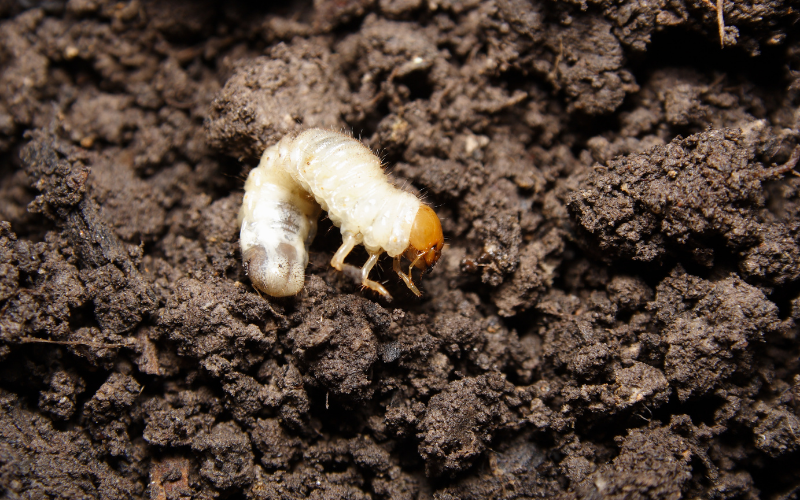Grubs are ugly and they can cause your lawn to thin, die, or be dug up by predators that want to snack on them.
While nearly all lawns have a few grubs, an infestation can cause massive damage in a short time.
To keep your lawn looking its best, keep an eye out for the following 5 signs of grubs in your lawn.

Signs of Grubs in Your Lawn (The Short Answer)
There are 5 primary signs of a grub infestation and most of them are easy to spot.
Grubs eat at the roots of your grass and, with enough grubs, you will see the grass die quickly, leading to rapid thinning and the development of many disconnected brown spots.
You may also notice that grub predators like moles and skunks are frequenting your lawn to feast on the rapidly expanding grub population.
How to Tell If You Have Lawn Grubs (5 Signs)
Almost every lawn in the US will have grubs. As long as you don’t have too many, grubs shouldn’t be a problem, they’re just something that lives in the soil that you generally won’t have to think about.
However, if you have seen some of the following signs, you may want to perform a test to determine just how bad your infestation is.
This is how to tell if grubs are killing your grass:
Thinning Grass
What does your lawn look like if it has grubs? One word: Thin.
Lawns with too many grubs have difficulty maintaining a lush, full appearance as the grubs indiscriminately chew the roots systems of random clumps of grass.
From far off this will always take the appearance of a thin, patchy lawn.
Circular or Irregular Brown Patches
If you have small, circular or irregular brown patches in your lawn that cannot be explained by other means, you may have grubs.
As grubs eat the roots of your grass, that grass will die and create a brown spot.
Beetles
The typical lawn grub is a white grub that turns into a beetle when mature.
These beetles are often called “water beetles”. They’re smaller than most grubs and have a hard, brown shell.
If you see dozens of these beetles on or buzzing around your lawn, it may be a sign that you could have a grub infestation the following year.
Moles, Voles, Skunks, and Armadillos
If you have a mole, vole, skunk, or another grub-predator issue, it doesn’t necessarily mean you have a grub problem.
However, moles are one of the best and easiest to notice indicators that your lawn may have more grubs to offer than your neighbor’s lawn.
Loose Grass or Detachment
A common sign that you have grubs rather than another type of root problem is loose grass in dry soil.
The grass may even feel “squishy” like there is thin mud or an air bubble under your feet even when the lawn is perfectly dry.
This will progress to full detachment, where you can lift the grass just as easily as you can lift the lid off of a pot.
The roots will appear to be roughly shorn off. However, you may not see any grubs underneath.
If things have progressed this far, the grub will have moved on to an adjacent section of your lawn to find more roots to eat.
How to Tell If You Have a Grub Problem
If you suspect a grub problem after reading the information above, there is a very simple test you can do to see if you have a true grub problem
All you need is a sharp spade and a pair of garden gloves. A hand rake can be helpful but isn’t necessary.
- Choose two 1 ft. sections of the lawn where you suspect grubs may be causing damage. Work on one section at a time.
- Cut the first 1 ft. lawn section with the spade.
- Dig down about 2 inches and pry up the small area of lawn.
- With the grass side down, count any visible grubs on the dirt side of the sod you just removed as well as any grubs visible in the top 1″ of soil beneath the grass that you just dug up. You can use your fingers or a small hand rake to find and remove these grubs.
- Follow the above steps for the second 1 ft. section of the lawn.
How many grubs did you end up with? If there were 6 or fewer grubs per section, you have an average number of grubs per square foot. This is usually not cause for concern or treatment.
If you have 9 or more grubs per foot, you may have a grub infestation on your hands that needs treatment.
If you have 7 or 8 grubs per foot I would err on the side of caution and consider treatment, though this is not yet considered to be enough grubs for an infestation.
If you do have an infestation, it may be worth learning about what causes grubs in your lawn and how to prevent a grub infestation, so that once you’ve applied a treatment, you can take steps to minimize the risk of the grub population increasing to dangerous levels again in the future.


Leave a Reply